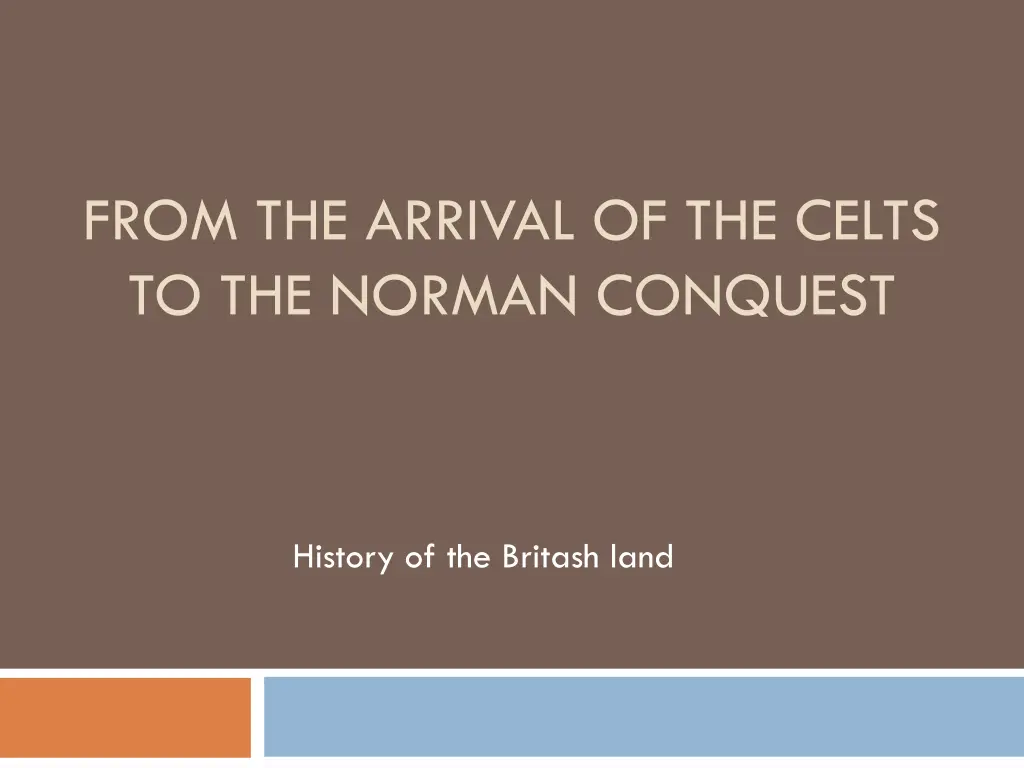
The History of British Land: Celts to Norman Conquest
Discover the fascinating journey of the British land from the arrival of the Celts near the Rhine to the Norman Conquest in 1066. Explore the Celts, Romans, Anglo-Saxons, and Vikings who influenced the cultural landscape of Britain. From hunting and farming societies to invasions and cultural shifts, this historical account sheds light on the diverse phases that shaped Britain's history.
Download Presentation

Please find below an Image/Link to download the presentation.
The content on the website is provided AS IS for your information and personal use only. It may not be sold, licensed, or shared on other websites without obtaining consent from the author. If you encounter any issues during the download, it is possible that the publisher has removed the file from their server.
You are allowed to download the files provided on this website for personal or commercial use, subject to the condition that they are used lawfully. All files are the property of their respective owners.
The content on the website is provided AS IS for your information and personal use only. It may not be sold, licensed, or shared on other websites without obtaining consent from the author.
E N D
Presentation Transcript
FROM THE ARRIVAL OF THE CELTS TO THE NORMAN CONQUEST History of the Britash land
The Celts Came from the regions near the Rhine Landed British land from 900BC to 1066 Divided into 2 tribes: Britons and Gaels Society based on hunting and farming The Druids ( religious leaders ) transmit the culture
The Romans: conquest 55 BC first Romans ( under Ceaser ) attempt to conquer England resistance from the local Celtic tibes and Romans failed 43 AD second attempt after 3 years they gaining control of the Central and Shouheastern regions 61 AD opposition of Boudicca Romans never managed to own Walas and Scotland
The Romans: domination Emperor Hadrian orders the construction of a defensive wall across northern Britain ( Hadrian s wall ) Romans built avast network of roads, imported techniques, habits and lifestyle The effects of Roman presence weren t permanent ( language and beliefs remain the same )
The Romans: the end IV century the Roman empire began to decline Germanic tribes invated Britannia 307 Roman officials weren t send to Britannia 410 end of the Roman rule
The Anglo-Saxon: invasions Divided into 3 tribes ( the Angles, the Saxons, the Jutes) 450 began raiding Britannia Local British tribes try to fight ( myth of King Arthur ) They pushing the local Celtic tribes away future Wales, Scotland and Ireland
The Anglo-Saxon: society and culture Hierarchial society Warriors promised loyalty to the thanes (comitatus) they receive land, riches and power Oral culture, symbolized by the mead-hall Litterature handed down by scops s songs From 597 onwards, Christian monks handed down their literature
The Viking: invasions 750-1050 they started carring out frequent raids Didin t find any resistance End of 9 century King Alfred the Great organized a fleet and succeeded in limiting the Viking incursion
The Norman: invasion 1066 William Duke of Normandy defeated King Harold at the Battle of Hastings William the Conqueror became the first Norman King of England Old French became the language of the court Old English was confined to the lower orders of society
Woman in Aglo-Saxon society The lifestyle, habits and chores depended on her social class Woman were potrayed as a cloth-makers and embroiderds Girls could express their opinion about mariage Woman could have their personal possesion Woman could leave her husband and still have a right to half of their property( if children remaind with her )


